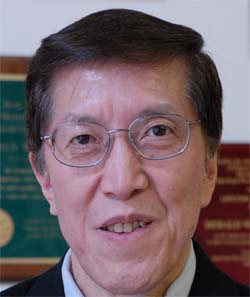Watch Derald Wing Sue in Live Interview Jan. 30, 7:30-8 p.m., With International Talk Show Host Thom Hartmann
Derald Wing Sue, Professor of Psychology, will be interviewed live on Jan. 30 by international talk show host Thom Hartmann. The interview, part of Hartmann's "The Big Picture" series on "Conversations With Great Minds," will be about Race Talk and the Conspiracy of Silence: Understanding and Facilitating Difficult Dialogues on Race. The book is Sue's newest work on microaggressions and the sequel to his highly successful Microaggressions in Everyday Life: Race, Gender and Sexual Orientation.
Viewers in New York City may listen live on Friday from 7:30 p.m. to 8 p.m. (EST) at Time Warner channel 135 or Verizon FiOS channel 278. For information on where to view around the world or to view the taped interview online after its conclusion, go to http://www.thomhartmann.com/tv/stations .
While Sue's earlier book focuses on behavior, this recent work focuses on speech. No matter how well-intentioned the participants, conversation about race can misfire badly and spark anger, resentment and misunderstanding-'"even violence. Precisely because of its power to hurt, talking about race needs to be acknowledged, understood and facilitated. That is the book's central theme, with suggestions on how to get there.
Sue's research shows that unsuccessful dialogues on race have major consequences for persons of color, including negative effects on their mental and physical health, and that they can depress classroom- and work productivity and problem-solving abilities. They are also harmful to white Americans by lowering their capacity for empathy and compassion, diminishing their perceptual awareness and accuracy, and deceiving them about the nature and operation of racism and their own complicity in its perpetuation. Indeed, the research shows that we do far more harm than good when we stay silent about race.
To facilitate successful dialogue about race, the book suggests five things not to do (do nothing, sidetrack the conversation, appease the participants, terminate the discussion, or become defensive); and eleven strategies that increase the chance of success (including, understand your racial and cultural identity; acknowledge and be open to admitting your racial biases; validate and facilitate discussion of feelings; control the process, not the content, of race talk; and validate, encourage, and express admiration and appreciation to participants who speak when it feels unsafe to do so).
The book is the product of 10 years of research and observation of people "engaged in difficult conversations on race, racism, whiteness and white privilege," Sue writes in the preface. His research team "discovered that almost all difficult dialogues on race were triggered by racial microaggressions that were often invisible to perpetrators." Microaggressions are subtle, making it difficult for the victim to respond without being misunderstood as petty or hypersensitive. But they can create serious problems, Sue writes, "often containing a disparaging message to people of color who find them offensive, [and] triggering intense emotional responses."
"Microaggressions is a term coined by Harvard University professor Chester M. Pierce in 1970 to mean the subtle but highly damaging manifestations in speech and behavior of prejudice and racism, often by people who do not acknowledge their own biases. Microaggressions in Everyday Life, published in 2010, is a scholarly work for mental health practitioners, academics and students that discusses microaggressions with respect to race, gender and sexual orientation. Race Talk and the Conspiracy of Silence focuses on seemingly harmless speech that belies unacknowledged or even unconscious racism in the speaker and, unintentionally or not, hurts or offends its target. Race Talk, while valuable for mental health professionals, is for parents, teachers, trainers and facilitators-'"anyone who wants to understand why it's so difficult to talk honestly about race.
Ironically, race talk is a particular problem in the work settings and in classrooms which have become increasingly diverse, often polarizing coworkers or students and teachers and leading to less clarity and more animosity regarding race, race feelings, and relationships. But while unsuccessful race talk can have disastrous consequences, it can also present "an opportunity for growth, improved communication, and learning." Sue said in a recent interview.
While it is true that fostering successful racial dialogue needs to start with children before they acquire the subtle cultural and racial biases that impede it, ultimately, the elimination of contentious race talk from schools will not be enough to eradicate racism. "Structural, systemic biases-'"those things need to change," Sue said. "We are disconnected in education from wider society." Policies and strategies that claim to be colorblind are not helpful, because, unconsciously or not, they silence the importance of racial and ethnic identity. "To be colorblind is to be color-mute," he said.
"The attitudes, beliefs and fears inherent in race talk symbolize our society's resistance to unmasking the embedded inequities and basic unfairness imposed upon citizens of color," Sue writes. "Race talk potentially makes the -'invisible' visible and opens gateways to view the world of oppression through realistic eyes. It has the possibility of helping us become nonracist and antiracist."
Published Thursday, Jan. 29, 2015
